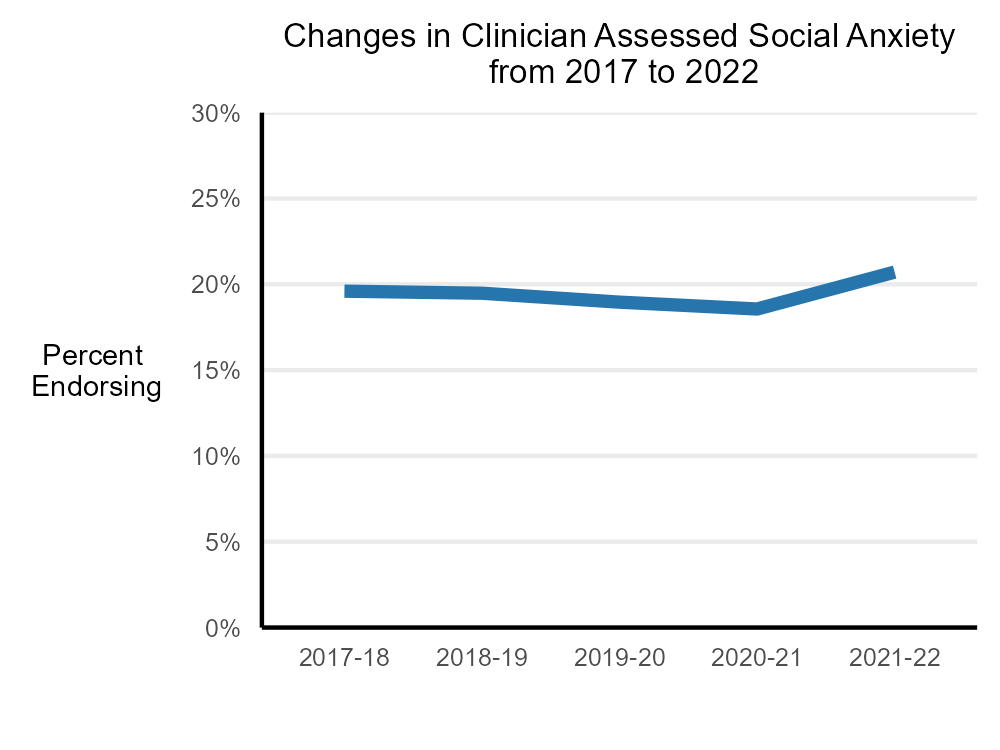Trends in Social Anxiety Symptoms and Isolation in Students Seeking College Counseling Services
The Center for Collegiate Mental Health (CCMH) 2022 Annual Report highlighted that Social Anxiety is the area of distress that demonstrated the largest 12-year increase among students seeking services at college counseling centers nationally. Social anxiety has been found to be prominent among college students and linked to mental health problems later in life (Purdon et al., 2001; Schry et al., 2012). Clients with higher social anxiety symptoms utilize more UCC services (Kilcullen et al., 2021; Janis, 2017) and experience stigmatization (Anderson et al., 2015). Thus, it is important to better understand current trends in social anxiety for students seeking college counseling services to provide clinicians and institutions with nuanced information that may inform care and programs. In the current blog, we further explored the trends in social anxiety, including information from clinicians’ assessments, as well as co-occurring problems that are associated with social anxiety. Specifically, the following questions were answered:
- What specific self-reported social anxiety symptoms have increased over the past 12 years?
- Have the rates of social anxiety assessed by clinicians changed over the past 5 years?
- Do clients with clinician assessed social anxiety have different rates of co-occurring problems than those without social anxiety?
What specific self-reported social anxiety symptoms have increased over the past 12 years?
Client self-reported social anxiety was examined using the Counseling Center Assessment of Psychological Symptoms (CCAPS). For reference, the seven social anxiety items or symptoms on the CCAPS are scored on a five-point Likert scale ranging from 0 (not at all like me) to 4 (extremely like me). Additionally, the symptom of social isolation was examined, which is an item from the CCAPS Depression subscale. The figure below displays the increases in the seven social anxiety symptoms and social isolation from 2010 to 2022.
Overall, concerns that others do not like me was the social anxiety symptom that increased the most over the past 12 years. This was followed by feeling self-consciousness around others, trouble making friends easily, feeling uncomfortable around unknown and known others, anxiety about public speaking, and shyness around others. Feelings of isolation also notably increased across the 12 years.

Have the rates of social anxiety assessed by clinicians changed over the past 5 years?
To address this question, five years of data (2017 to 2022) were examined from the Clinician Index of Client Concerns (CLICC). The CLICC is a checklist of 54 presenting concerns that is designed to capture the most common presenting concerns of counseling center clients, as assessed by clinicians during an initial appointment.
The figure below depicts the annual prevalence of students with social anxiety (check-all-that-apply) that was identified by clinicians. From 2017 to 2021, social anxiety was identified as a presenting concern in approximately 20% of students, which slightly decreased over the four-year period. However, there was a small increase in 2021-2022, which might be related to the transition from widespread remote learning environments in 2020-2021 to more traditional in-person academic experiences in 2021-2022, resulting in students abruptly encountering more stress inducing social situations.

Do clients with clinician assessed social anxiety have different rates of co-occurring problems than those without social anxiety?
Co-occurring problems, as assessed by clinicians on the CLICC, were compared between students with and without social anxiety who were treated at college counseling services nationally in 2021-2022. In the table below, the prevalence rates for co-existing concerns for those with and without social anxiety are outlined and listed in descending order based on the actual percent differences between the groups.
Individuals with social anxiety, compared those without, are substantially more likely to have several co-morbid clinical problems, including generalized anxiety, depression, and eating disorder symptoms. Additionally, students entering counseling services with social anxiety are more likely to experience social/academic stressors, such as interpersonal functioning, confidence problems, social isolation, adjustment issues, and academic performance concerns.
Summary and Implications
The following takeaways are noted:
- Client self-reported social anxiety is the area of distress that demonstrated the largest 12-year increase among students seeking services at college counseling centers nationally. All symptoms of social anxiety increased in the past 12 years, as well as feelings of isolation, which is a depression symptom. The symptoms that have demonstrated the largest increases are concerns others do not like me, feeling self-conscious around others, difficulty making friends, and feeling uncomfortable around others unknown to them.
- While self-reported social anxiety increased in the past 12 years, conversely, clinician identified social anxiety slightly decreased from 2017 to 2021. However, consistent with student client self-report, there was a notable increase in clinician identified social anxiety in 2021-2022, which might be related to the abrupt transition to in-person academic instruction and social experiences after the widespread remote year of learning in 2020-2021.
- Individuals with social anxiety, compared to those without, are substantially more likely to have several co-occurring clinical problems, including generalized anxiety, depression, and eating disorder symptoms. Additionally, students beginning treatment with social anxiety are more likely to be experiencing a host of social/academic concerns, including interpersonal functioning, confidence problems, social isolation, adjustment issues, and academic performance issues.
- College counseling centers and institutions should be aware that student clients are increasingly entering counseling services with social anxiety symptoms and feelings of isolation, which is a trend that began at least 12 years ago and was recently exacerbated upon the return to in-person instruction in 2021-2022. All symptoms of social anxiety increased in the past 12 years, including those that reflect social comparison processes (concern others do not like me, self-conscious around others), and, to a lesser extent, symptoms that indicate behavioral avoidance (shyness around others, isolation - depression). These national trends highlight the importance of institutions understanding and addressing the specific symptoms and how concerns are being expressed within their local student population, as they can significantly impair students' abilities to effectively engage and be successful within an academic environment.



